Aquarium crayfish: what are they and how to keep them?
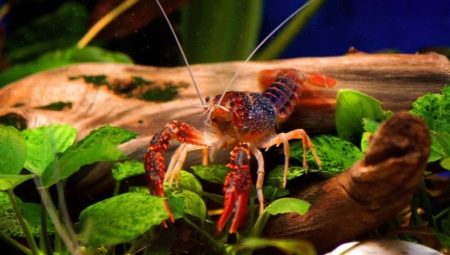
Aquarium crayfish are interesting, unusual and very active pets that can significantly diversify the life of a wildlife lover. These representatives of the order of arthropods adapt well to living conditions in an artificial reservoir. Even a novice aquarist can cope with the task of breeding them. Finding suitable pets is also not difficult - there are more than 100 species in the world that can exist in captivity. True, the life span of an arthropod is short - about 2-5 years.
To properly organize the maintenance of marble crayfish and representatives of other species in the aquarium, it is worthwhile to study the habits and needs of future pets in advance... How to feed them at home, how to provide conditions for breeding? Which species are suitable for captivity, can they share habitat with fish? Only after receiving answers to these questions, it is possible to acquire and populate new tenants in the aquarium.
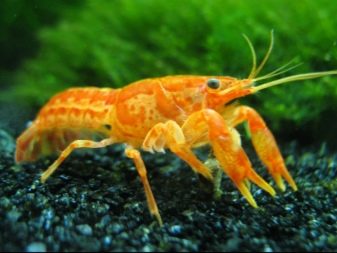

Description
Aquarium crayfish are vivid representatives of the order of arthropods, capable of living in an artificially created environment. Usually these are dwarf species, growing up to 10-20 cm in length, characterized by a peaceful, calm character. Crayfish that live in the aquarium are also called decorative for their predominantly bright color and unsuitability for food.
There are over 100 species of such diverse arthropods in the wild. Their characteristics:
- live in freshwater bodies;
- prefer flowing places well saturated with oxygen;
- demonstrate a high level of physical activity;
- feel the need to shed;
- have a varied body color - from brown-green to bright pink;
- breathe mainly with gills, receiving oxygen from the water;
- sensitive to the level of water pollution;
- feel the need for a cool environment (up to + 16-22 degrees);
- eat mainly plant foods (up to 90% of the diet);
- are nocturnal.
These are only general characteristics that do not take into account the characteristics of individual species. Before choosing a pet for settling in an aquarium, it is imperative to study the details about it, to clarify the needs in terms of keeping.
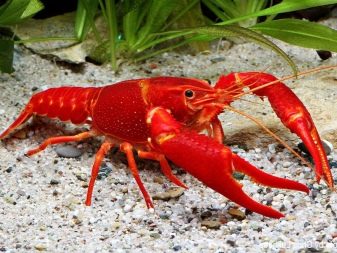
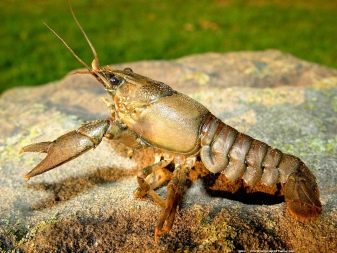
Overview of popular species
There are many types of aquarium crayfish. It is worth considering the most interesting views in more detail.
White
Extremely rare crustaceanfound in Europe. He prefers to stay in freshwater reservoirs and plant food. In an aquarium, crayfish can switch to protein foods, bloodworms, and raw meat. The offspring may have a bright red, yellow, orange body color.
Australian
Unusual blue crayfish with a greenish tint of chitin prefer to inhabit warm shallow reservoirs with fresh water. Representatives of this species are large enough, they grow up to 20 cm in length. Other salient features include bright red stripes on the claws. Australian crayfish are omnivorous, they can absorb both plant and animal food.
Cuban
Another blue cancer that changes in habitat can change the shade of the carapace from pale blue to deep brown. Adults reach 15 cm in length, with sufficient nutrition they are not aggressive towards fish. The lifespan of a Cuban cancer is about 3 years.
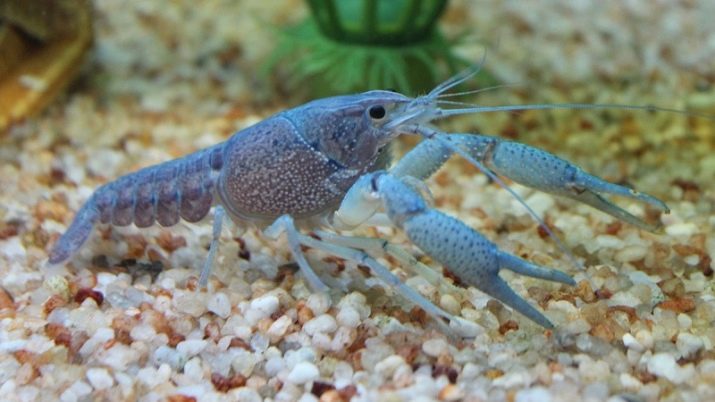
River
This wild type of cancer in its natural environment reaches a shell length of 25 cm, which makes it not the most convenient pet for home keeping. The arthropod prefers exclusively protein foods., actively hunts, not suitable for keeping with fish and smaller animals.
Crayfish of this species burrow into the ground, and therefore need sufficient quantities of it.
Mexican
Aquarium crayfish, in the chitinous cover of which a juicy orange color prevails. When raised in captivity, females grow larger than males. Wherein representatives of the species are vegetarians who do not consume animal protein... They are unpretentious in content. Mexican crayfish get along well with other representatives of the aquarium fauna.
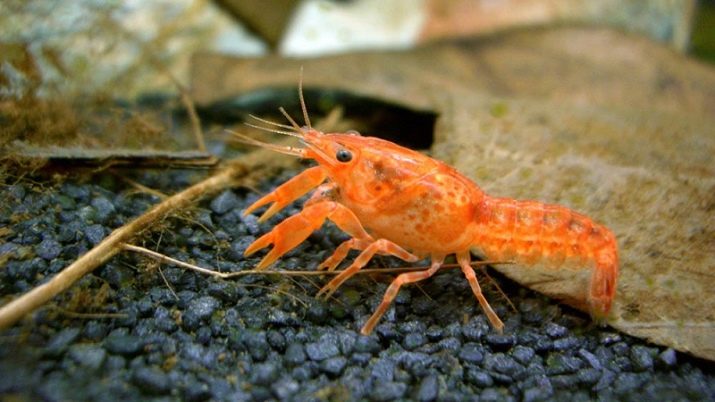
Florida blue
These decorative crayfish were born through painstaking selection. In nature, their river brother is brown in color. The body of this arthropod has a deep blue color, turns pale in the tail. Individuals are quite small in size - no more than 10 cm in length.
Despite its outstanding decorative characteristics, the Florida blue crayfish is a predator, showing aggressiveness towards shellfish, shrimp, and fish that are in the same tank with it.
Louisiana
A dwarf crayfish found naturally in the lakes of North America. On the dorsal part of the shell of this crustacean there is a characteristic black spot. The compact size allows you to keep the arthropod with the fish, without risking their life. The content of Louisiana crayfish is unpretentious, it is content with the remnants of algae, the decaying bodies of fish.
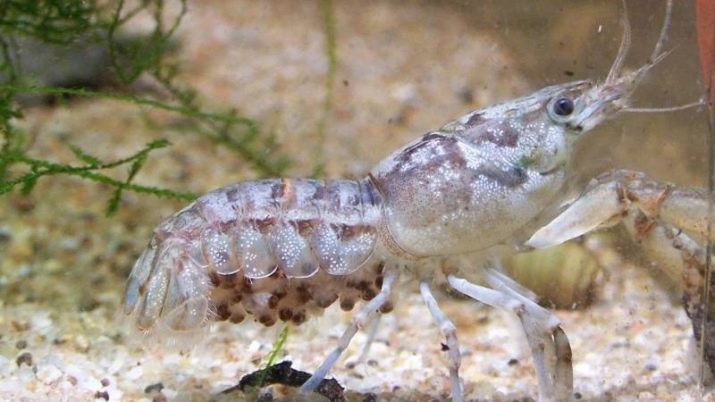
California red (Florida)
The bright red hue of the shell distinguishes this crustacean favorably from representatives of other species. The arthropod is a real decoration of the aquarium, in addition to decorativeness, it is highly active, including in the daytime. When kept in captivity, it is imperative to provide control over access to the exit from the container.
Crayfish leave an open aquarium quite easily. The body length of an adult animal is about 14 cm.
Marble
The marble crayfish got its name due to its unusual black-brown color. These compact arthropods reach a body length of up to 13 cm, are unpretentious in keeping, suitable for joint settlement with medium-sized fish. A beautiful color of the shell is formed in adult animals; young animals have a less bright shade of chitinous cover. Marble crayfish need the obligatory presence of protein food in the diet, it helps to ensure the full development of individuals during the growth period.
A distinctive feature of this species is that all of its individuals are exclusively females. They do not need a partner to reproduce. The marble crayfish is found in Australia and is called Yabbi in the Aboriginal language.
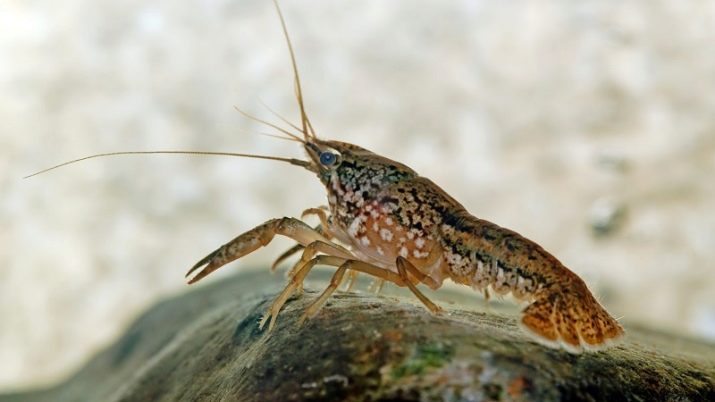
Features of the content
Aquarium crayfish can be kept in an aquarium without too much hassle. Caring for them at home is about feeding them regularly and providing a safe environment. The type and quality of the soil is of particular importance here. For individuals caught in the river, it will be necessary to equip a reservoir with a sandy bottom and aquatic plants. Pets grown in artificial conditions can be kept without abundant vegetation.
The minimum volume of an aquarium for keeping ornamental crayfish is 70 liters. If there are several individuals, it is better to give preference to a tank of 100-120 liters. The following points are important for keeping crayfish.
- Formation of a soil layer at the bottom. Its thickness should be at least 60 mm, the structure is soft and loose. In this case, crayfish will comfortably dig holes and shelters for themselves. The optimal solution is considered to be brick chips, river pebbles, artificial filler. It is permissible to use soaked expanded clay.
- Placing on the bottom of driftwood, plants with raised roots. In the places where they are located, crayfish dig their shelters. In the absence of thickets, arthropods in the aquarium feel uncomfortable and anxious. Even in the presence of decorative artificial shelters, crayfish will still try to bury their bodies deeper into the ground.
- The use of plants. Cancers actively cut and eat them. That is why you need to choose for an aquarium with them plants with the most developed and powerful root system, large leaf size. A suitable option would be cryptocorynes, apnogetones.
- High quality water filtration. Crayfish are sensitive to cleanliness of conditions, especially in a closed ecosystem, where insufficient care can lead to outbreaks of bacterial infections. Biological filters cannot cope with cleaning tasks - it is imperative to buy and install additional and rather powerful equipment. If the permissible level of microbes is exceeded, it is imperative to change the water. Under normal conditions, this procedure is required no more than 1 time per month.
- Control over the hydrochemical parameters of the environment. The optimal temperature values are considered to be 20-26 degrees Celsius. The acidity of the water should vary between pH 5-8. Stiffness does not have a radical significance, but too low parameters negatively affect the course of the molt period.
Aquarium crayfish are not overly sensitive to lighting conditions. Minimal illumination is enough for them due to the predominantly nocturnal lifestyle.


Molting period
The cultivation of aquarium crayfish is inextricably linked to this natural process. Throughout their life, arthropods continue to grow, periodically getting rid of the old chitinous cover. It is during molting that the crustacean acquires a new shell, which reliably protects it from the attacks of enemies. But the behavior of pets during this period of time is very different from usual.
Moulting crayfish are best kept separate from other animals or fishbecause they become inactive and especially vulnerable to external influences. To wait, arthropods choose a secluded shelter and almost stop moving and be active.Having thrown off the old cover, crayfish gradually build up a new one, replenishing the calcium reserves by eating the old chitinous membrane - this is a natural process, there is no need to interfere with it. The new shell will grow in 7-10 days.
During the first year of life, crayfish molt quite often. On average, this process is repeated every 2 months. Adult animals grow much more slowly. They molt once every 6 months. It gets rid of the old cover of the arthropod in a few minutes.

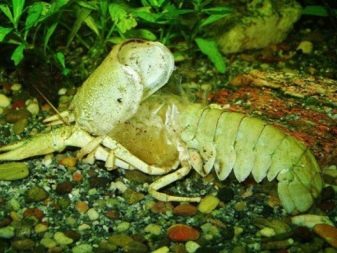
Feeding
In their natural environment, crayfish are almost omnivorous, but, despite their predatory nature, are predominantly vegetarians... They can be fed in captivity with almost any natural food that does not contain chemical and artificial additives. To create a balanced diet, you can use ready-made crustacean food from a pet store. During molting, arthropods feed most abundantly, they require additional supplements in the form of tableted vegetable feed and calcium.
It is useful to give crayfish natural algae, plants, fresh vegetables - cucumbers, zucchini, cut into small pieces. Frozen shrimp are used as protein supplements. But their number should be strictly regulated, since with an abundance of animal food, crustaceans begin to show aggression. Also, when kept with small fish, larger arthropods often feed on them, showing natural instincts. Crayfish are fed once a day.
If food is not eaten completely, its remnants must be removed. Decaying food leads to a deterioration in the conditions of keeping pets.
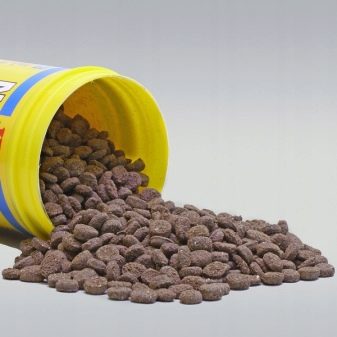
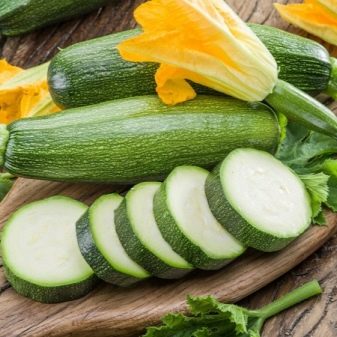
Fish Compatibility
The compatibility of aquarium crayfish with fish can be called rather arbitrary. The following things can happen when you are in the neighborhood with other inhabitants of the aquarium.
- Cancers can suffer from stress and lack of food. This happens especially often when living side by side with cichlids - a large aggressive neighbor will deprive arthropods of rest and food. In the future, crayfish will only die if they are not promptly relocated to a separate aquarium.
- Arthropods can tolerate competition when seeking cover. Catfish have similar tastes in choosing a temporary shelter. They are the ones who most often enter the fight against crayfish for a safe haven and emerge victorious because of their larger size.
- Crayfish can eat other inhabitants of the aquarium. As food, crayfish are considered most of the small fish - under the threat of guppies, neons and similar species.
- Crayfish can spoil their fins, disrupting the aesthetics of their neighbors. It is not recommended to place crayfish together with the owners of long decorative "ornaments". Tails and fins can suffer from their claws.
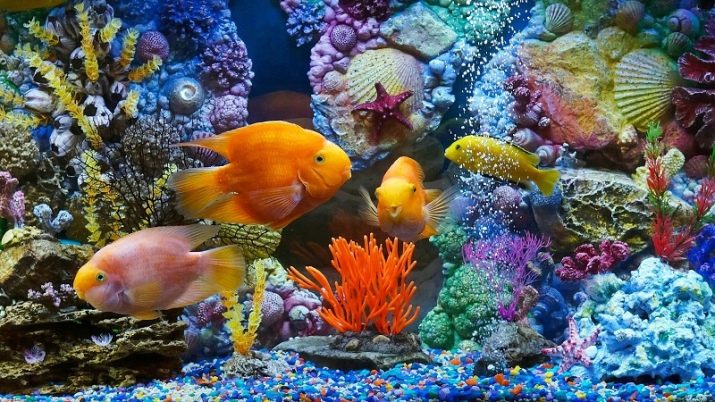
Objectively assessing all the pros and cons of the neighborhood, we can conclude that crayfish are not created for a safe and prosperous neighborhood with fish. If possible, they should be kept in a separate aquarium, otherwise predatory instinct will force arthropods to attack smaller neighbors. At the same time, the cancer itself may well suffer from an attack by fish, especially during the molt period, when its shell is still quite soft. In addition, they are dangerous for plants - cutting them with claws, arthropods feast on fresh food, but rather quickly destroy all green spaces in the aquarium.
Among the species that are ready for the neighborhood with other inhabitants of the artificial "house", the following crayfish can be noted:
- blue Cuban, he is reputed to be the most peaceful;
- red or blue Florida (if using plastic plants);
- zebra;
- Australian redclaw.
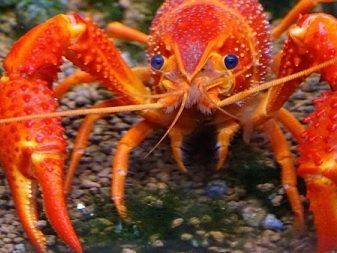
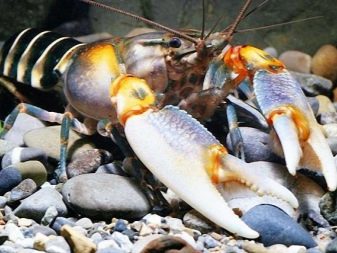
When keeping fish and crayfish together, it is very important to create an optimal environment for all species. To do this, you need a spacious aquarium with a capacity of at least 100 liters. It is necessary to select its inhabitants in approximately the same weight and size category.
Inside, it is necessary to provide a sufficient number of secluded shelters - coconut shells, pipes and fragments of clay pots, piles of natural stones look spectacular. Instead of natural plants, artificial analogs are used in an aquarium with crayfish.
To keep crayfish, it is imperative to use well-filtered and purified water. To exclude the possible leaving of the aquarium by arthropods, it is imperative to cover it with glass, leaving a minimum gap for air exchange. It is better to choose young crayfish for hooking up with fish.
They are planted one at a time, transported in an opaque tank.
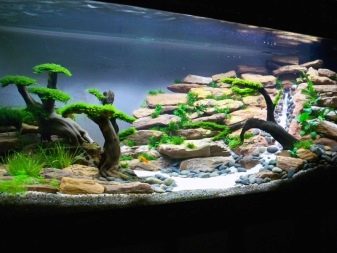
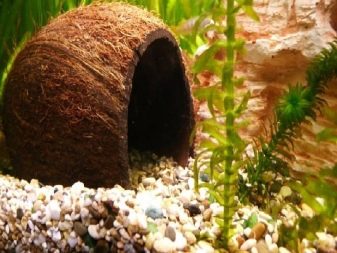
Breeding
Even an inexperienced aquarist can successfully breed the most exotic crayfish species. To successfully carry out the necessary manipulations, you will only need to add different-sex individuals to the tank, 2 females per male (he can eat one after mating). Breeding can be carried out from the age of 3 months. It is during this period that cancers reach puberty. In males, an indicator of readiness for breeding is the appearance of bright red stripes on the surface of the claws.
The reproductive ability of crayfish is especially high in the post-molt period. At this time, females release pheromones - active substances that attract representatives of the opposite sex. During the mating ritual, individuals of different sexes make contact with the antennae, this process lasts about 120 minutes. Next, the female should be deposited in a separate tank.
Crayfish lay eggs 20-25 days after mating. For the period of gestation, the female needs to create special conditions, provide shelter, protect from dangers. After birth, babies until molt are on the mother's abdomen, they are helpless, in need of separate maintenance. After the crayfish receive their second chitinous cover, they are removed from the mother.
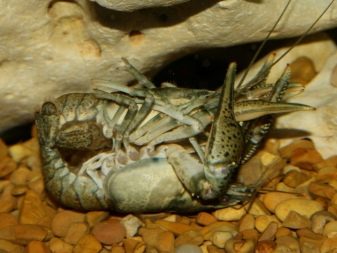
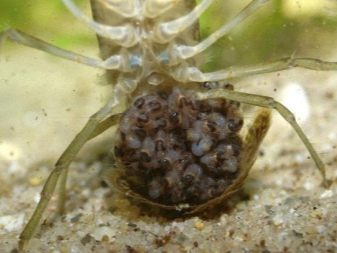
In the next video, you will find useful information about aquarium crayfish.








